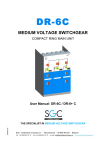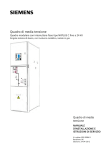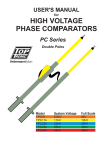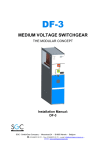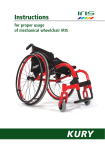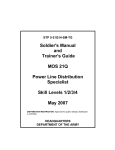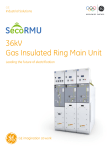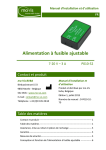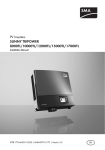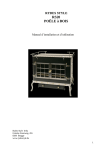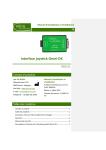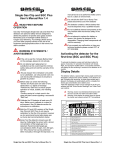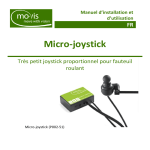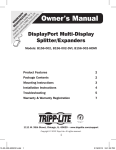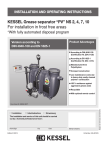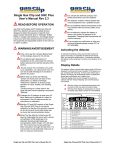Download Installation Manual: DR-6C / DR-6+ C - Elpro
Transcript
DR-6C MEDIUM VOLTAGE SWITCHGEAR COMPACT RING MAIN UNIT DW646314 Installation Manual: DR-6C / DR-6+ C THE SPECIALIST IN MEDIUM VOLTAGE SWITCHGEAR SGC - SwitchGear Company nv. - Moorstraat 24 - B-9850 Nevele - Belgium Tel : +32 (0)9/321.91.12 - Fax +32 (0)9/321.91.13 - e-mail: [email protected] - www.switchgearcompany.eu © 2013 SGC – SwitchGear Company nv All rights reserved. The information provided herein may not be reproduced and/or (re)published in any way and by any means (electronic or mechanical), without the prior, explicit written authorization of SGC - SwitchGear Company nv. The information provided herein is based on general data concerning the construction, known at the time of publication, and concerning the qualities of the material and working methods. Consequently, the right to make changes is reserved. The information contained within is applicable to the standard version of the DR-6 medium-voltage switchgear. Therefore, SGC - SwitchGear Company nv cannot be held liable for any damage resulting from specifications that differ from the standard version of the DR-6 medium-voltage switchgear. The available information has been assembled with the greatest possible care, but SGC - SwitchGear Company nv cannot be held liable for any mistakes in the information, or the consequences thereof. The user names, trade names, trademarks, etc., used by SGC - SwitchGear Company nv cannot, in accordance with the legislation concerning the protection of trademarks, considered to be free. ii Installation Manual – DR-6C/ DR-6+ C DW646314 CONTENTS CONTENTS .................................................................................................... iii PREFACE ....................................................................................................... v About this manual ....................................................................................................................... v Pictograms and safety symbols in and on the medium voltage switchgear ............................... v Pictograms in the documentation .............................................................................................. vi Related documentation .............................................................................................................. vi Service and technical support .................................................................................................. vii General safety directions and instructions ................................................................................ vii Intended use ............................................................................................................................. viii 1 INSTALLATION ...................................................................................... 1-1 1.1 1.1.1 1.1.2 1.1.2.1 1.1.2.2 1.1.2.3 1.1.2.4 1.1.2.5 1.1.2.6 1.1.2.7 Safety guidelines instructions – installation ........................................................... 1-1 General .................................................................................................................. 1-1 Recommendations – installation room parameters ............................................... 1-1 Floor surface .......................................................................................................... 1-1 Environmental conditions ...................................................................................... 1-2 Ventilation .............................................................................................................. 1-2 Free height of the installation area ........................................................................ 1-3 Sizes of the entrance doors to the installation area ............................................... 1-3 Free passage in front of the cubicles ..................................................................... 1-3 Internal arc protection ............................................................................................ 1-4 2 DR-6C INSTALLATION GUIDELINES ................................................... 2-1 2.1 2.1.1 2.1.2 2.1.3 2.2 2.2.1 2.2.2 2.2.3 2.2.4 2.3 2.3.1 2.3.2 2.3.3 2.3.4 Installation in the presence of a cable duct ........................................................... 2-1 General .................................................................................................................. 2-1 Required conditions ............................................................................................... 2-1 Diverting of the gases ............................................................................................ 2-2 Installation in the presence of an expansion room behind the switchgear ............ 2-3 General .................................................................................................................. 2-3 Required conditions ............................................................................................... 2-3 Required Materials ................................................................................................ 2-3 Diverting of the gases ............................................................................................ 2-4 Installation in the absence of a cable duct or transformer room ............................ 2-5 General .................................................................................................................. 2-5 Required conditions ............................................................................................... 2-5 Required materials ................................................................................................ 2-5 Gas escape route .................................................................................................. 2-6 3 DR-6+ C INSTALLATION GUIDELINES ................................................ 3-1 3.1 3.2 3.2.1 3.2.2 General .................................................................................................................. 3-1 Required conditions ............................................................................................... 3-1 Required Material .................................................................................................. 3-1 Diverting of the gases ............................................................................................ 3-2 4 Switchgear arrangement ...................................................................... 4-3 4.1 4.1.1 4.1.2 4.1.3 DW646314 Anchoring the DR-6C medium-voltage cubicle ...................................................... 4-3 Installing the fixation clips ...................................................................................... 4-3 Installing the fixation clips with use of a soccle ..................................................... 4-3 After installing the fixation clips, the DR-6C medium-voltage cubicle can be positioned in its definitive place. The rear side of the DR-6C medium-voltage cubicle is now fixed into place.Anchoring front side of DR-6C medium-voltage switchgear ............................................................................................................. 4-3 Installation Manual – DR-6C/ DR-6+ C iii 4.1.3 4.2 4.2.1.1 4.2.1.2 4.2.1.3 4.2.1.4 4.2.1.5 4.3 4.3.1 4.3.2 4.3.3 4.3.4 4.4 4.5 Anchoring front side of DR-6C medium-voltage switchgear .................................. 4-4 Assembly of the end panels .................................................................................. 4-6 Kit DR000010 (End Panel Left - Right) .................................................................. 4-6 Kit DR002010 (End Panel Left - Right) .................................................................. 4-6 Preparations .......................................................................................................... 4-7 End Panel Sealing Profile Assembly Guidelines ................................................... 4-7 Assembly Guidelines End Panel ........................................................................... 4-8 Cable connections, mounting floor panels ............................................................. 4-9 Preparations .......................................................................................................... 4-9 Optimal access to the cable compartment ............................................................ 4-9 Assembly guidelines for cable connection ........................................................... 4-11 Possible bushings ................................................................................................ 4-13 Refitting the door ................................................................................................. 4-15 Measuring phases sequence ............................................................................... 4-16 5 INITIAL COMMISSIONING..................................................................... 5-1 iv Installation Manual – DR-6C/ DR-6+ C DW646314 PREFACE About this manual This document is intended as a reference for qualified and trained operators to install the medium voltage switchgear in a safe and economical way. This document uses the term “medium voltage switchgear” to denote a random, but in actual practice, existing combination of DR6 functions that, mutually coupled and connected, constitute a client-specific transformation or distribution station. See: “General description”. The chapters and sections are numbered. The page numbers (consisting of the chapter number and the page number) and the document code can be found at the bottom of every page. In the documentation the words “left”, “right”, “front” and “behind” are used to indicate a specific part of the medium voltage switchgear. The starting point is always the position of the operator, standing in front of the medium voltage switchgear, facing the switchgear. Pictograms and safety symbols in and on the medium voltage switchgear Depending on the version, the following pictograms are used on the medium voltage switchgear: WARNING Danger of high voltage Access to this cubicle is only allowed after this cubicle and both the directly adjacent cubicles (previous and next one) are de-energized. WARNING Drilling prohibited. Drilling is strictly prohibited on surfaces equipped with this pictogram. DW646314 Installation Manual – DR-6C/ DR-6+ C v Pictograms in the documentation The following pictograms apply to the medium voltage switchgear user documents: CAUTION! A procedure that can, if not carried out with the proper care, result in damage to the medium voltage switchgear, the surrounding area or the environment. WARNING High Voltage Danger CAUTION! Clamping danger Notes, suggestions and advice. Make this cubicle, the next one and the previous cubicle, voltage-free, before carrying out the work described. Open the load break switch and the earthing switch before carrying out the work described in the manual. Consult the indicated information sources first. Protect the medium voltage switchgear from water and damp. Related documentation The following technical documentation for medium voltage switchgear is available: • Transport manual DR-6C • User manual DR-6C vi Installation Manual – DR-6C/ DR-6+ C DW646314 Service and technical support For information concerning specific settings, maintenance or repair work which are not covered in the manual, please contact SGC - SwitchGear Company nv. • When contacting SGC – Switchgear Company nv, always provide the following information: − Cubicle designation and characteristics − Serial number of the cubicle(s) General safety directions and instructions SGC – SwitchGear Company nv does not accept any liability for damage or injury caused by not (strictly) following the safety directions and instructions, or by negligence during the installation, use, maintenance, or the repair of the medium voltage switchgear and its accompanying options. Depending on specific user circumstances, or installed options, extra safety instructions may be required. Please contact SGC – SwitchGear Company nv immediately if you encounter a potential danger during the operation of the medium voltage switchgear. The owner/operator of the medium voltage switchgear is fully responsible at all times for following the locally applicable safety directions and guidelines. User manual • Anyone who uses or operates the medium voltage switchgear, must be familiar with the contents of the user manual, and follow the directions contained within very closely. The owner/operator must educate the users in accordance with the user manual and obey all directions and instructions. • Never change the order of the required actions. • Always keep the user manual in the vicinity of the medium voltage switchgear. Pictograms and safety symbols The pictograms, symbols and instructions applied to the medium voltage switchgear are a part of the safety equipment. They may therefore not be covered or removed, and must be present and clearly readable throughout the entire lifespan of the medium voltage switchgear. • Replace or repair unreadable or damaged pictograms, symbols and instruction immediately. Therefore, contact SGC – SwitchGear Company nv. Operators The execution of the work described (transport, installation, use and maintenance) is strictly reserved for trained and qualified operators, who are familiar with the dangers that can occur when operating medium voltage switchgear. Temporary staff and personnel in training may not operate the medium voltage switchgear under any circumstances. DW646314 Installation Manual – DR-6C/ DR-6+ C vii Technical specifications • Technical specifications may not be changed. • Modification of the medium voltage switchgear (or parts thereof) is not permitted. Transport, storage, installation, operation and maintenance • See corresponding documents: − “Safety guidelines – transport” − “Safety guidelines – storage” − “Safety guidelines – installation” − “Safety guidelines – operation” − “Safety guidelines – maintenance” Intended use The medium voltage switchgear is designed exclusively for use as transformation or distribution stations, in accordance to the specifications and conditions provided by SGC – SwitchGear Company nv. Any other or further use is not in accordance with the intended use.1 SGC – SwitchGear Company nv does not accept any liability for damage(s) or injuries resulting from deviation(s) of the intended use. The medium voltage switchgear complies with the current norms and guidelines. See: Technical Brochure • Only use the medium voltage switchgear in technically perfect condition, in accordance with the intended use described above. Leave the sealed connections intact, at all times. Breaking the sealed connections irrevocably voids any guarantee claims. 1 The “Intended use” as defined in EN 292-1 “is the use for which the technical product is suited as specified by the manufacturer including his directions in the sales brochure.” In case of doubt, it is the use that can be deduced from the construction, the model and the function of the technical product that is considered normal use. Operating the product within the limits of its intended use also involves observing the instructions in the user manual. viii Installation Manual – DR-6C/ DR-6+ C DW646314 1 INSTALLATION 1.1 Safety instructions – installation 1.1.1 General Installation of the medium voltage switchgear is restricted to qualified and trained operators with strictly observance of the locally applicable safety instructions and guidelines. The connection and commissioning must be done by qualified and authorized staff employed by the power supplying company. • • • See also: "General safety prescriptions and instructions". Never leave tools or other material in or on top of the medium voltage switchgear. Install the medium voltage switchgear exclusively in spaces that fully comply with the following recommendations (according to IEC 62271-200): 1.1.2 Recommendations – installation room parameters Recommendations regarding the installation room parameters are subdivided in recommendations concerning: • floor surface • environmental conditions • ventilation • free height of the installation area • sizes of the entrance doors of the installation area • free passage in front of the cubicles • internal arc protection 1.1.2.1 Floor surface The surface on which the medium voltage switchgear must be installed, needs to firm and completely level. The maximum permissible difference in level is 2 mm/m. DW646314 1-1 1.1.2.2 Environmental conditions DR-6C cubicles have been designed for indoor installation, provided that the following environmental conditions are met: description environmental temperature relative air humidity (%) installation altitude (m.a.s.l.) values min. -15 °C - max. +45 °C min. 10% - max. 70% (without condensation) max. 1.000 m above sea level Table 1: Environmental conditions Consequently this means: • Avoid installation in dusty areas. • Avoid installation in areas with a high relative air humidity. • Avoid installation in areas subject to lightning strikes. • Avoid installation in surroundings where cubicles may be exposed to corrosive gases or fluids. Contact SGC – SwitchGear Company nv when cubicles must be installed in areas where the required environmental conditions cannot be guaranteed. 1.1.2.3 Ventilation • • Ensure proper ventilation of the installation area. Protect the ventilation ducts so that small animals or vermin do not have acces to the installation area. Particularly when the medium voltage switchgear contains one or more transformer cubicles, special attention should be given towards ventilation. Consult the table below when calculating the required ventialtion. The table indicates the power losses of the cast resin transformers. Transformer Capacity (KVA) 100 160 250 315 400 500 630 800 1.000 1.250 1.600 2.000 P (W) 1.605 2.175 2.850 3.412 4.012 4.837 5.745 6.787 7.875 10.350 12.450 16.125 Table 2: Overview of capacity losses in cast resin transformers 1-2 DW646314 1.1.2.4 Free height of the installation area The free height of the installation room has to be at least 2.000 mm. Local power supply companies may however, require a larger minimum free height. An ideal, and generally accepted, value is 2500 mm. Dry transformers with a capacity of ≥ 1.250 KVA require a minimal height of at least 2.500 mm. 1.1.2.5 Sizes of the entrance doors to the installation area The provided dimensions apply to all doors that offer access to the installation room. These minimum requirements also apply if the installation room is not directly accessible from the outside. description Height of the access door Width of the access door value min. 2200 mm min. 100 mm + width of the widest cubicle Table 3: Dimensions of the access doors If the medium voltage switchgear does not contain any transformer cubicle(s), a minimal door height of 2.000 mm will be sufficient. If a transformer cubicle is included, the dimensions of the transformer always need to be taken into account. For the correct dimensions of the different cubicles, please see: “Dimensions & Weights”. If the medium voltage switchgear is to be installed in basements, an entrance hatch is required, whose length as well as width is at least 400 mm larger than the dimensions of the largest cubicle or transformer. 1.1.2.6 Free passage in front of the cubicles The free passage in front of the cubicles depends on the composition of the medium voltage switchgear. If the medium voltage switchgear does not contain any transformer cubicle(s), the minimum free passage is 800 mm. Medium voltage switchgear with a transformer cubicle having a capacity of ≥ 1.000 KVA requires a free passage of at least 2000 mm. DW646314 1-3 1.1.2.7 Internal arc protection To prevent major material damage and serious physical injury or electrocution in the (unlikely) event of an internal arc, the following installation instructions apply: • Between the rear side of the cubicles and the wall of the installation room, the necessary free space needs to be provided, as displayed in Figure 1. This layout corresponds with an assembly where the side plates of the cubicles reach the rear side of the installation room. As a result, the free space behind the cubicles is closed off. Figure 1: Top view of installed cubicles A transformer cubicle can always be positioned with its rear side against the wall. 1-4 DW646314 Figure 2: Minimal free height for DR-6 installation Anchor each cubicle of the medium voltage switchgear to the floor as described in §4.1 Anchoring the DR-6C medium voltage switchgear. Ensure proper fitment of the end panels. See “§4.2 Assembly of the end panels “ In medium voltage switchgear installed in accordance with the above described installation procedure, the (unlikely) internal arc will always be limited to the compartment of origin. DW646314 1-5 2 DR-6C INSTALLATION GUIDELINES 2.1 Installation in the presence of a cable duct 2.1.1 General The installation of the DR-6C RMU guarantees the highest possible degree of protection in the event of an internal error, by conducting the gas to the expansion volume in the cable duct. 2.1.2 • • • Required conditions Volume cable duct ≥ 0.7 m³ Pressure relief outlet with a minimum cross section of 0.04 m² is required in the switchgear room Ensure proper fitment of the end panels and seal off all other openings Figure 3: Top View of the installation DW646314 2-1 2.1.3 Diverting of the gases Figure 4: Diverting of the gas when installing the DR-6 RMU in a switchgear room with a cable duct (Lateral view of installation) 2-2 DW646314 2.2 Installation in the presence of an expansion room behind the switchgear 2.2.1 General The installation of the DR-6C RMU guarantees the highest possible degree of protection in the event of an internal arc, by diverting the gas to an expansion volume behind the switchgear (transformer compartment). 2.2.2 • • • Required conditions Volume expansion room ≥ 0.7 m³ Pressure relief outlet with a minimum cross section of 0.04 m² is required towards the switchgear room Ensure proper fitment of the end panels, the arc defection kit and seal off all other openings Figure 5: Top view of switchgear 2.2.3 • • Required Materials DR-6C Ring Main Unit Arc deflection kit, to be mounted on of the DR-6 RMU(DR029670) DW646314 2-3 2.2.4 Diverting of the gases Figure 6: Diverting of gases when the DR-6 RMU is installed in a switchgear room with an expansion volume behind the switchgear (Lateral view of installation) 2-4 DW646314 2.3 Installation in the absence of a cable duct or transformer room 2.3.1 General The installation of a DR-6C RMU, in the absence of a cable duct or a transformer room, guarantees the highest possible degree of protection in the event of an internal error, by diverting the gases to a certified DR-6C arc absorber. The arc absorber acts as a buffer volume. This drastically reduces the consequences of an internal arc in order to create safe operator conditions. 2.3.2 Required conditions During the installation special care should be given towards the overpressure valves on the arc-absorber, their function may not be limited in any way. Figure 7: Top view of switchgear 2.3.3 • • Required materials DR-6C Ring Main Unit DR-6C arc absorber (DR029670) DW646314 2-5 2.3.4 Gas escape route Figure 8: Diverting of the gases when installing a DR-6C arc-absorber (Lateral view of installation) The height of the socle below the arc-absorber, needs to correspond with the regulations for bending radius of the installed cable. 2-6 DW646314 3 DR-6+ C INSTALLATION GUIDELINES 3.1 General The installation of the DR-6C RMU guarantees the highest possible degree of protection in the event of an internal arc, by extinguishing it in less than 50 ms. The rapid arc extinction limits the internal pressure build-up, which prevents the escape of gas. 3.2 Required conditions To provide the highest possible degree of protection in the unlikely case of a malfunction of the arc extinction system (SV-50), a pressure relief vent is provided. To guarantee the perfect functioning of the overpressure vent, the free space between the rear side of the cubicles and the wall of the installation area needs to be respected. The installation should not in any way limit the functioning of the overpressure vents. Figure 9: Top view of switchgear 3.2.1 • Required Material DR-6+ C Ring Main Unit DW646314 3-1 3.2.2 Diverting of the gases Figure 10: Gas escape route when placing the switchgear DR-6+ C with a cable cellar available (Lateral view of installation) Figure 11: Gas escape route when placing DR-6+ C switchgear without a cable cellar (Lateral view of installation) The height of the socle below the switchgear, needs to correspond with the regulations for bending radius of the installed cable. 3-2 DW646314 4 SWITCHGEAR ARRANGEMENT 4.1 Anchoring the DR-6C medium-voltage cubicle 4.1.1 Installing the fixation clips Before positioning the DR-6C switchgear in its definitive place, install a fixation clip (see Figure 15) for every function of the DR-6. Figure 12: Positioning: Installing fixation clips After installing the fixation clips, the DR-6C medium-voltage cubicle can be positioned in its definitive place. The rear side of the DR-6C medium-voltage cubicle is now fixed into place. 4.1.2 Installing the fixation clips with use of a soccle Before positioning the DR-6C switchgear in its definitive place, install a fixation clip (see Figure 15) for every function of the DR-6. Figuur 13: Opstelling: Plaatsen bevestigingsbeugels bij montage DR-6 op sokkel After installing the fixation clips, the DR-6C medium-voltage cubicle can be positioned in its definitive place. The rear side of the DR-6C medium voltage cubicle is now fixed into place. DW646314 4-3 4.1.3 Anchoring front side of DR-6C medium-voltage switchgear Figure 14: Positioning: Anchoring DR-6C medium-voltage switchgear Consult the installation drawing(s), the electrical schematics, and the floor plans before starting with the actual positioning of the medium-voltage switchgear. Leave the indicated free space between the rear side of the cubicle and the wall of the installation room. This allows the overpressure system to function correctly in the event of an internal arc. A transformer cubicle can be placed with its rear side against the wall. 4-4 DW646314 • Position the medium-voltage switchgear perfectly level, after anchoring the fixation clips, in its definitive place in the installation room. The rear side of the DR-6C mediumvoltage switchgear is now fixed into place. Figure 15: DR-6C medium-voltage switchgear installed in its definitive installation room • Anchor each functional unit to the floor using two bolts (A). Use the provided openings as seen in Figure 18. If required, the anchoring can happen after disassembling the floor panels (B) and the front panel of the cable compartment (C). Figure 16: Positioning: Anchoring a DR-6C medium-voltage cubicle Ensure that the cubicle remains exactly aligned and perfectly level to enable a torque-free assembly of the frame. Any plinths are provided ex factory and will be supplied separately. Position the cubicles in the order indicated on the installation drawings and the electrical diagram. DW646314 4-5 4.2 Assembly of the end panels A special kit is available for the assembly of both the left and right end panels. 4.2.1.1 Kit DR000010 (End Panel Left - Right) Kit Contents Order number Description Number Pos. Number RM021000 End panel 2 A RM021016 Sealing profile end panel 2 B 1 C 14 D 12 E 5 F Set of fixing materials end panel DR-6 M8x16 RIPP self-locking GR040986 hexagonal flange bolt M8 RIPP self-locking GR041308 hexagonal flange nut Self-drilling hexagonal GR046413 collar-head bolt GR017809 4.2.1.2 Kit DR002010 (End Panel Left - Right) Kit Contents Order number Description Number Pos. Number RM021001 Socle Back panel 200mm 2 A RM021016 Sealing profile end panel 2 B 1 C 14 D 12 E 5 F Set of fixing materials end panel DR-6 M8x16 RIPP self-locking GR040986 hexagonal flange bolt M8 RIPP self-locking GR041308 hexagonal flange nut Self-drilling hexagonal GR046413 collar-head bolt GR017809 The assembly kit also contains the following items: 4-6 Order number Description Number DF045600 Control handle 1 TO400006 Sign DR-6/vital 5 1 DW646112 Manual DR-6 medium-voltage switchgear 1 DW646314 4.2.1.3 Preparations Ensure that the cubicle, the next one, and the previous one are de-energized and earthed 4.2.1.4 End Panel Sealing Profile Assembly Guidelines Figure 17: End panel sealing profile assembly (left and right) • • • Place the sealing profile on the inside of the end panel, in such a way that the end panel’s pattern of holes and the sealing profile match. Secure the sealing profile to the end panel using five provided self-drilling hexagonal collar-head bolts (F) for every end panel The result is a left (sealing profile on the right side) and a right (sealing profile on the left side) end panel, which can be assembled to the medium voltage cubicle, as outlined in §Error! Reference source not found.. DW646314 4-7 4.2.1.5 Assembly Guidelines End Panel Figure 18: Assembly End Panel • • Place the end panel against the lateral wall of the cubicle, in such a way that the end panel’s pattern of holes and the lateral wall match. Secure the end panel using the provided fixing materials, by using the M8x16 RIPP self-locking hexagonal flange bolts(D) and the M8 RIPP hexagonal flange nuts (E). Torque MA equals 42Nm. If the wall is not perfectly straight, a finishing profile needs to be installed to guarantee a perfect sealing. 4-8 DW646314 4.3 Cable connections, mounting floor panels During the installation of the medium-voltage switchgear, the assembly of the floor panels happens simultaneously with the connection of the cables, the descrition of these actions are combined. The following applies in all circumstances: Cable connections can only be carried out by qualified and authorized staff in service of the power supply company, using only fixing materials provided by SGC – SwitchGear Company nv. Cables must never cross each other. 4.3.1 Preparations Ensure that the cubicle, the next one, and the previous one are de-energized and earthed 4.3.2 Optimal access to the cable compartment The DR-6 medium-voltage switchgear is designed to connect the cables in the most comfortable way, Therefore, the front panel of the cable compartment (C) can be disassembled easily (Figure 19). The front panel of the cable compartment (C) is fixed with four self-securing hexagonal flange bolts (A) and four self-securing flange nuts (B). Figure 19: Disassembling the front panel of the cable compartment DW646314 4-9 After disassembling the front panel of the cable compartment, the firstbottom panel (D) can be removed from the cable compartment, after disassembling the self-locking hexagonal flange nuts (E). Now the cable grommets (F) can be removed from the cable compartment. Figure 20: Disassembling the first bottom panel The rear bottom panel (G) is to be installed according to Figure 21, after disassembling the two self-securing hexagonal flange nuts (H). Figure 21: Disassembling the rear bottom plate 4-10 DW646314 4.3.3 • Assembly guidelines for cable connection Unscrew, for every cable support (Figure 22 B+C), the hexagonal tap bolts (Figure 22 A) to allow disassembly of the twofold cable support. Depending on the size of the diameter of the cable, it might be necessary to disassemble the cable support entirely (Figure 22 D.) • • • Figure 22: Assembly of the bottom panel Use a sharp knife to make a number of cuts in the cable grommet (Figure 23 F.) Slide the cable grommet over the cable socket. Connect the cable to the bushing: o Assemble the cable connection (Figure 23 E) according to the supplier’s installation instructions. The entire bushing needs to be carefully coated with a layer of silicone grease, which can be found in the cable connection kit. • Slide the cable grommet (Figure 23 F) over the cable at the proper height. Figure 23: Assembly of the cable connection • • • Place the first part of the cable clamp (Figure 24 C) between the cable (Figure 24 E) and the cable support (Figure 24 D). Now place the second part of the cable support (Figure 24 B) over the cable and fix the cable support by screwing in the hexagonal tap bolts (Figure 24A) on both sides. Torque MA equals 40Nm. Continue for the remaining two phases according to the instructions detailed above. Figure 24: Assembly of the cable supports DW646314 4-11 • Connect the three earthing cables (Figure 26 G) to the cable support using two selfsecuring hexagonal flange bolts (Figure 26 H) and two self-securing hexagonal flange nuts (Figure 26I). Torque MA equals 40Nm. • Place the bottom plate (Figure 27 J) right in the cable compartment and position the cable grommets (Figure 27 K) in such a way that the bottom panels are fixed into place. • Connect the front bottom panel (Figure 28 L) in such a way that the cable grommets are fixed by both bottom panels. Fix both bottom panels using four self-securing hexagonal flange nuts (Figure 28 M). • Finally, the front panel (Figure 25 N) of the cable compartment needs to be reinstalled using four self-securing hexagonal flange bolts (Figure 25 O) and two self-securing hexagonal flange nuts (Figure 25 P). Figure 25: Assembly of the front panel of cable compartment Figure 26: Assembly of the earthing cables Figure 27: Positioning of the rear bottom panels Figure 28: Putting back bottom panels After assembly of the bottom panels (and connection of the cables), the doors can be put back onto the cubicles. In functional units where the cable connection has not (yet) occurred, the earthing switch needs to be locked in the closed position, or the bushings need to be equipped with a proper socket. 4-12 DW646314 4.3.4 Possible bushings The DR-6C medium-voltage switchgear is equipped with bushings in compliance with Cenelec EN50181 and IEC 60137 for cable connections. • Interface C (screw connection M16x2) 400 series, In = 630A Type K functional units default. Interface A with plug 200 series, In = 250A Type T functional units default. • Figure 29: Cable transit type Interface C Figure 30: Cable transit type Interface A Plug/cable supply manufacturer’s installation instructions need to be followed strictly. The following rules need to be taken into account at all times: • Thorough cleaning of the bushings and cable connection • The entire bushing needs to be carefully coated with a layer of silicon grease over the entire surface (denoted in blue). The grease is available in the cable connection kit. • When connecting the cables, the prescribed torque needs to be respected. Examples of proper cable connections: Manufacturer Name of cable support Diameter conductor [mm²] In [A] Type of cable transit Euromold K400TB/G 35-300 630A Interface C Euromold K158LR/G 16-70 250A Interface A The following manufacturers of cable connections are recommended: o Euromold/Elastimold o Tyco Electronics DW646314 4-13 4.4 Refitting the door For refitting the door, the load break switch must be in the OPEN position and the earthing switch in the CLOSED position. • • • • Carefully check whether there are any tools or fixing materials left in the cable compartment. Check all connections. Attach the door (B) to the cable compartment: o Grasp the door with both hands using the handle(D). o Carefully position the door in the supports. o Push the door downward. Lock the door with a reliable padlock (C) on the locking latch (A). Figure 31: Placing the door back A specially appointed, qualified operator must retain the keys. DW646314 4-15 4.5 Measuring phases sequence The phase sequence is usually measured between K functions. The phase sequence can be measured easily using the voltage indicators (A) on the front panel, • Measure using a voltage meter/phase sequence indicator (B) between the corresponding phases. A phase sequence indicator (RM086000) is optionally available. If no voltage can be measured, the phase sequence is correct. Measuring the voltage between two different phases allows you to check the measurement. Obviously a voltage should be measured in this case. 4-16 Figure 32: Measuring phase sequence DW646314 5 INITIAL COMMISSIONING The actual connection to the MV grid and the initial commissioning of the medium voltage switchgear can be done by qualified and trained staff employed by the power supply company only, observing the locally applicable safety regulations. Notes: DW646314 5-1 THE SPECIALIST IN MEDIUM VOLTAGE SWITCHGEAR DW646314 ©2013 SGC – SwitchGear Company nv





































